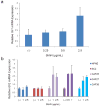Overexpression of smoothened activates the sonic hedgehog signaling pathway in pancreatic cancer-associated fibroblasts
- PMID: 20215540
- PMCID: PMC2846609
- DOI: 10.1158/1078-0432.CCR-09-1913
Overexpression of smoothened activates the sonic hedgehog signaling pathway in pancreatic cancer-associated fibroblasts
Abstract
Purpose: Accumulating evidence suggests that cancer-associated stromal fibroblasts (CAF) contribute to tumor growth by actively communicating with cancer cells. Our aim is to identify signaling pathways involved in tumor-stromal cell interactions in human pancreatic cancer.
Experimental design: We established primary fibroblast cultures from human pancreatic adenocarcinomas and nonneoplastic pancreas tissues. To identify differentially expressed genes in CAFs, we did gene expression profiling of human pancreatic CAFs and nonneoplastic pancreatic fibroblasts.
Results: The Hedgehog receptor Smoothened (SMO) was upregulated in CAFs relative to control fibroblasts. CAFs expressing SMO could transduce the Sonic hedgehog signal to activate Gli1 expression, and small interfering RNA knockdown of SMO blocked the induction of Gli1 in these cells. Stromal fibroblasts of human primary pancreatic adenocarcinomas overexpressed Smo compared with normal pancreatic fibroblasts.
Conclusions: These findings implicate overexpression of Smo as a mechanism for the activation of Hedgehog signaling in human pancreatic CAFs and suggest that stromal cells may be a therapeutic target for Smo antagonists in pancreatic cancer.
Figures




References
-
- Jemal A, Siegel R, Ward E, Hao Y, Xu J, Thun MJ. Cancer Statistics, 2009. CA Cancer J Clin. 2009;59:225–49. - PubMed
-
- Hartel M, Di Mola FF, Gardini A, et al. Desmoplastic reaction influences pancreatic cancer growth behavior. World J Surg. 2004;28:818–25. - PubMed
-
- Yauch RL, Gould SE, Scales SJ, et al. A paracrine requirement for hedgehog signalling in cancer. Nature. 2008;455:406–10. - PubMed
-
- Hahn H, Wicking C, Zaphiropoulous PG, et al. Mutations of the human homolog of Drosophila patched in the nevoid basal cell carcinoma syndrome. Cell. 1996;85:841–51. - PubMed
Publication types
MeSH terms
Substances
Grants and funding
LinkOut - more resources
Full Text Sources
Other Literature Sources
Medical
Molecular Biology Databases
Research Materials
Miscellaneous

